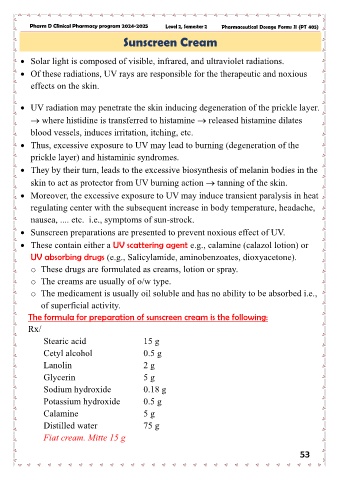Page 54 - Practical DF2 Corrected (2)
P. 54
Pharm D Clinical Pharmacy program 2024-2025 Level 2, Semester 2 Pharmaceutical Dosage Forms II (PT 405)
Sunscreen Cream
• Solar light is composed of visible, infrared, and ultraviolet radiations.
• Of these radiations, UV rays are responsible for the therapeutic and noxious
effects on the skin.
• UV radiation may penetrate the skin inducing degeneration of the prickle layer.
→ where histidine is transferred to histamine → released histamine dilates
blood vessels, induces irritation, itching, etc.
• Thus, excessive exposure to UV may lead to burning (degeneration of the
prickle layer) and histaminic syndromes.
• They by their turn, leads to the excessive biosynthesis of melanin bodies in the
skin to act as protector from UV burning action → tanning of the skin.
• Moreover, the excessive exposure to UV may induce transient paralysis in heat
regulating center with the subsequent increase in body temperature, headache,
nausea, .... etc. i.e., symptoms of sun-strock.
• Sunscreen preparations are presented to prevent noxious effect of UV.
• These contain either a UV scattering agent e.g., calamine (calazol lotion) or
UV absorbing drugs (e.g., Salicylamide, aminobenzoates, dioxyacetone).
o These drugs are formulated as creams, lotion or spray.
o The creams are usually of o/w type.
o The medicament is usually oil soluble and has no ability to be absorbed i.e.,
of superficial activity.
The formula for preparation of sunscreen cream is the following:
Rx/
Stearic acid 15 g
Cetyl alcohol 0.5 g
Lanolin 2g
Glycerin 5g
Sodium hydroxide 0.18 g
Potassium hydroxide 0.5 g
Calamine 5g
Distilled water 75 g
Fiat cream. Mitte 15 g
53

